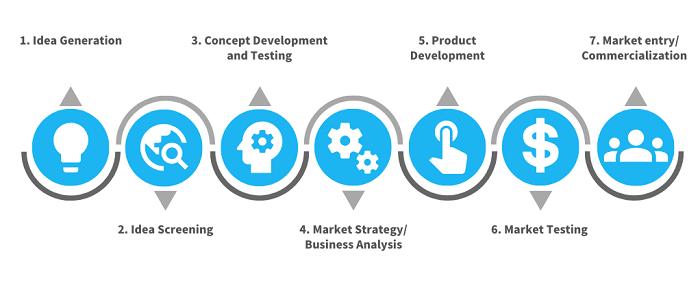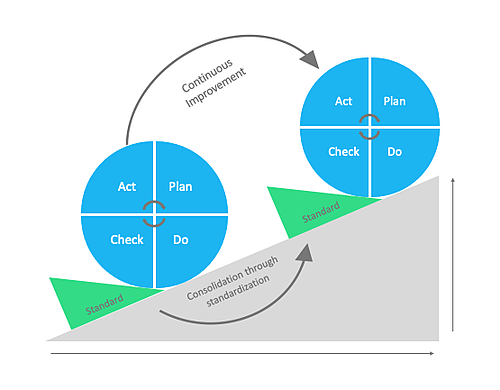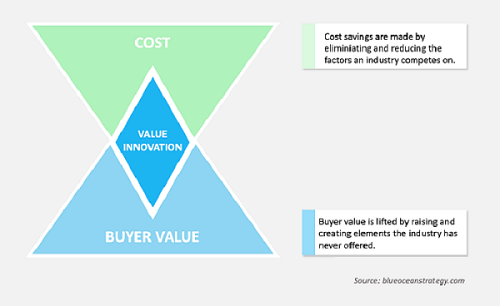Product Innovation
What is it and how to do it right? – PART 2
Published on June 16, 2021 – 7-minute reading
Article in English
Source: here
Product innovation in practice
Now that we clarified what is product innovation and what it implies, let’s see how it works in practice. For this, we’ll look at some of the most common strategies, frameworks, and theories that make product innovation happen:
#1. NPD – New Product Development
In a time when technology and communication channels are so easily accessible at large scale, anyone can make and launch products. The bar has been lowered, but not when it comes to good product development. Increased competition led to higher standards, so the bar is actually higher if you want to have a successful product on the market.
New Product Development, or NPD is the process through which companies take a product from concept to market. It can refer to completely new products or improvements of existing ones. Depending on industry or company, the process can, of course, be different.
We laid out below the most common seven stages new products normally go through. It starts with the ideation and concept generation and ends with the launch and introduction to the market. Keep in mind that these illustrate the most common approaches to NPD but they are by no means a silver bullet.

#2. Continuous improvement processes
Just like NPD, this one is a high-level approach you should keep in mind as it involves a strategic, organization-wide process.
If you’re a regular reader, you are already familiar with continuous improvement as we’ve discussed this topic at length in other articles. However, we think it’s important to specifically mention the important role continuous improvement plays in product innovation.
If you embrace continuous improvement in your organization, it will only become natural to make better products and win that competitive advantage. As everyone involved in developing products is systematically engaged in doing a better job day after day, their strive for excellence will pay off on the long term. Constantly improving on your products will give you a steady advantage and you won’t be left behind.
There are many ways through which you can get there, and we also wrote about the continuous improvement processes and how to choose those that match your needs.

There are several continuous improvement processes and one we can mention briefly is the PDCA cycle (Plan, Do, Check, Act). This process supports the principles and practice of continuous improvement and Kaizen. Kaizen is actually the philosophy stemming from Japanese car manufacturers and is focused on making small changes every day to contribute to major improvements over time.
#3. Blue Ocean Strategy
Blue Ocean Strategy is a theory developed by W. Chan Kim and Renée Mauborgne in their book with the same title. Their approach includes a set of tools and frameworks that enable companies to capture Blue Oceans which are the unexplored areas of the market.
It can be used to pursue differentiation, open up new market spaces and create new demand. The authors point out that fighting with competitors on a crowded market, the red oceans, is rarely a winning strategy, and by creating an uncontested market space for yourself, you are paving your way to success.
How does it look in practice?
Let’s take the example of Nintendo, a company lost in the Red Ocean of console games that couldn’t keep up with all the technological advances in the industry. Instead of giving up, they captured the attention of a new, more casual audience, drifting away from the hard-core gamers everyone in the industry had focused on for decades.

Committed to new markets and to value innovation, they launched Nintendo Wii in 2006 and won over families and children. With a significant lower cost, a few novel features, and a wireless motion control stick, they were back in the game. Their focus on value innovation was the winning strategy. However, to save costs and increase buyer value at the same time, they had to reimagine the market and redefine what quality means for their new segment.
#4. Jobs To Be Done
You’re probably familiar with Jobs To Be Done, a framework for identifying customer needs. It’s all about finding out what kind of jobs consumers hire their products to do. However, there’s a bit more to it than just asking your customers the reasons for their choices. If you simply ask why they chose a certain product, you will rarely understand their needs in enough detail.
Going deeper, to the root causes of their choices, opens the door to real, value-adding innovation. These are the needs customers often didn’t even know they had. In an HBR (Harvard Business Review) article, Clayton Christensen explains how this framework works and why companies win with innovation once they understand how and why customers make certain decisions.
How does it look in practice?
Consider Nike, one of the best-selling athletic apparel and footwear companies to this day. When they first got started, they developed a product that performed a job that others had failed to get right. Nike co-founder, Bill Bowerman, originally a track and field coach set on a mission to help athletes run faster. His interest in making shoes perform the job athletes needed done led to the invention of top Nike shoe brands like Cortez or Waffle Racer. Nike switched from distributing other footwear brands to creating their own.
It’s important to look at products through the lens of jobs to be done because it can broaden your business horizons and help you identify new opportunities that others haven’t already tackled.
How to do product innovation right?
Leading companies have a balanced portfolio that mixes niche products, entirely new developments and improved products. Their key to success, as reported by McKinsey seems to be in their systematic approach to product innovation that includes a closely monitored and tracked strategic process as well as great collaboration and implementation capabilities.
McKinsey identified in their analysis four major factors that contribute to the success of product development. However, these are not necessarily the same for every organization, so try to identify the capabilities you need for the kind of product innovation you’re doing. Regardless, here are four you might want to consider:
#1. Collaboration
The ability to manage and unite teams towards a specific goal is essential for any type of innovation. It’s a myth that innovation is a solo activity. Some people can be better at ideation when they are on their own, but making innovation happen requires more brainpower as well as diverse talent capable of performing different kind of tasks required to create and deliver great products to the market.
#2. Strategy and planning
This step is often underestimated by many companies as they want to fast forward to the development or testing phases. Product innovation requires excellence in strategy and planning because there is so much work in preparing a truly innovative product. Plans should be thorough, and they should include different scenarios that assess and mitigate risks.
It’s not to say that you should linger on the strategic phase for too long. If you find yourself stuck in this phase, by the time you are ready to act, it might already be too late. It’s important to get the big picture right, decide which direction is right for you and then be fast and agile in testing, learning and adapting on the way.
#3. Thorough analysis of the market
Before getting to the drawing board, you need to do your research. What’s the demographic like, what needs is your product answering, and what differentiates you from the competition? Think here at the Jobs To Be Done theory and the Blue Ocean framework.
As previously mentioned, don’t get stuck here for too long. If you are not up to speed, your research might be in vain. So once again, be flexible about your plan and revise things as you move ahead.
#4. Training teams in charge of launching products
Speaking of the capabilities of your workforce, we’ll state the obvious, that you need to get the best people for the job. They are crucial for the success of your product innovation.
Once you have the right people keep in mind that for innovation to happen, teams should be trained to strive for excellence. This is of course more complex, and it requires a certain environment that allows an innovation culture to flourish. Successful companies know that investing in training and developing their people will add to the outcome of the product.
To this, it’s worth adding some more specific product-related factors that can have an impact on the final result:
#1. Compelling value proposition
This is probably the single most common failure companies may go through in the process and it takes us back to the jobs that customers need done. Your value proposition is what sets you apart. It should be clear how your product is providing a solution to specific customer needs. All too often companies just create « cool gadgets » that don’t really add value to anyone.
#2. Low friction
For products to be adopted at a large scale, they have to be straightforward, easy to understand, and easy to use.
#3. Product portfolio integration
Deciding on the next product or improvements should always be consistent with the big picture goals and strategy of your organization. Are these innovation initiatives taking you in the right direction and contributing to a balanced product portfolio?
Author of the article
Diana Porumboiu
Marketing Manager, Viima | Finland
Related services – Executive Programs and Training
- Product Development and Management – How to develop the successful product: From dream to reality.
- MODULE 03 – Planning & Roadmap: How to communicate a high-level vision of your product and service offering.
- MODULE 04 – Market & Competition: How to identify trends, innovation potential, risks and opportunities.
- MODULE 05 – Innovation & Technology: How to build and lead a culture of innovation to innovate better, faster and bolder.
- MODULE 07 – Financing & Investment: How to ensure your investment addresses market opportunities and customer needs.
- MODULE 08 – Prototyping & Industrialisation: How to prototype, test and produce to meet customer expectations.
Categories
Tags
Product Manager
Subscribe to our blog
Do you want to better understand the world around you and adapt to its constant changes?
Would you like experts to inform, explain and decipher the latest news and best practices in innovation, agile leadership, product and service development, digitalization, and its transformation?
Fields with an asterisk (*) are mandatory.

COVID-19
© 2016-2021 AlpRocket – All right reserved

